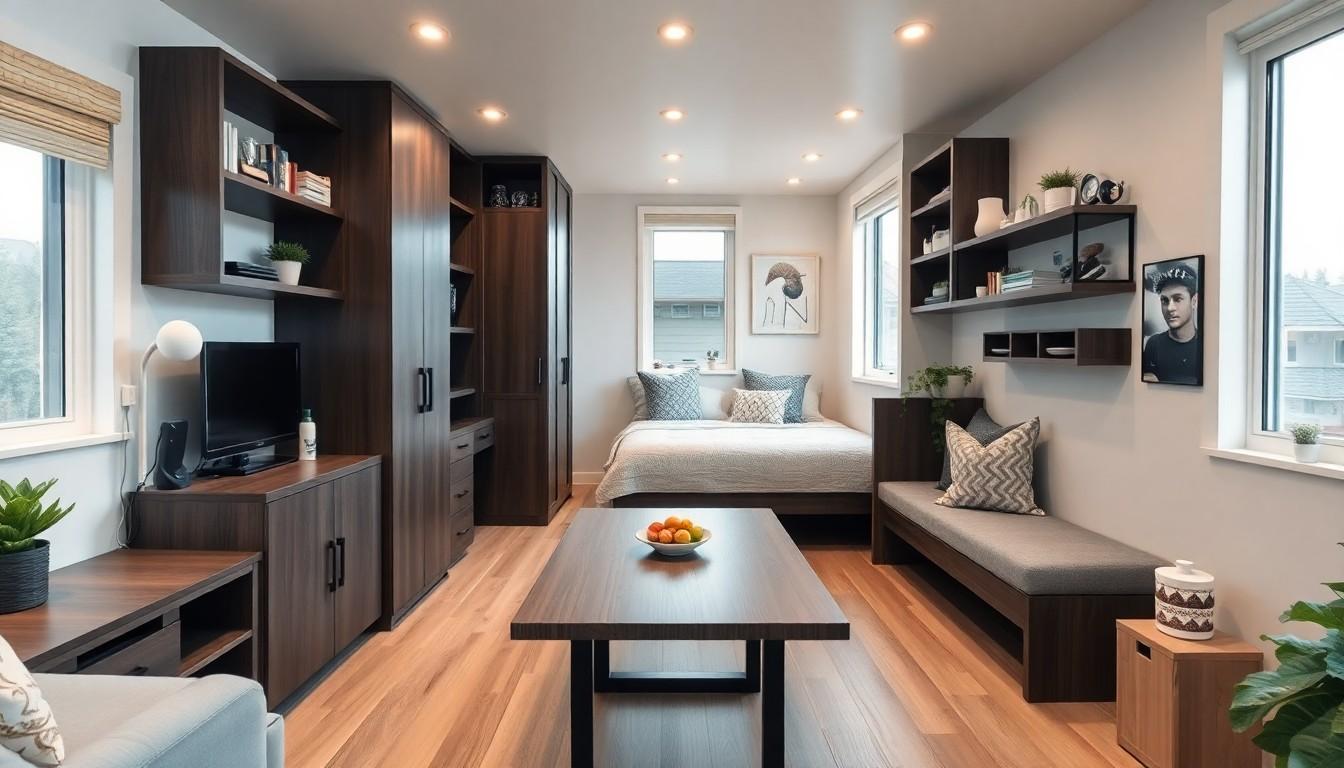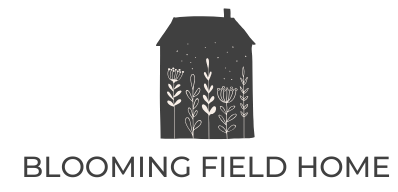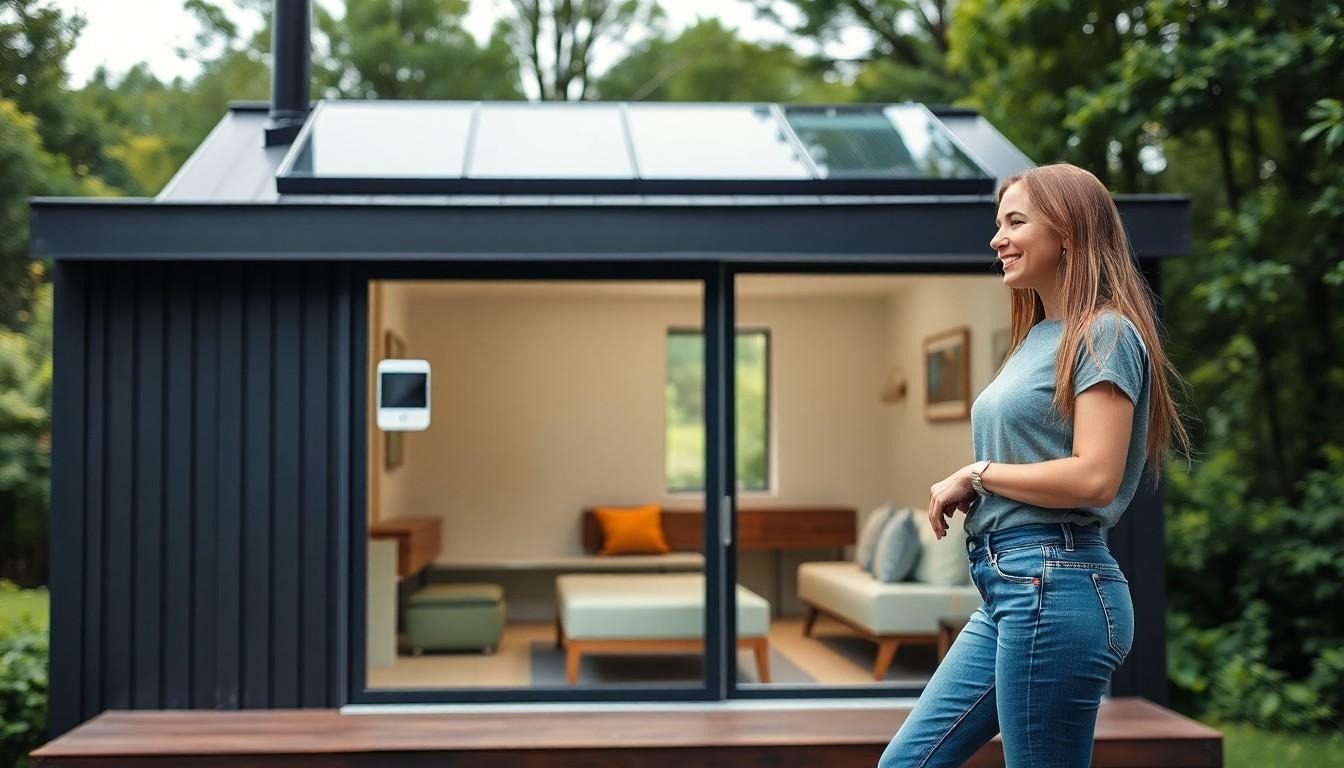In a world where bigger isn’t always better, smart tiny homes are turning heads and changing lives. These compact living spaces pack a punch with innovative technology and clever design, proving that you don’t need a mansion to live large. Imagine all the comforts of home, but with the added bonus of a lower carbon footprint and a budget-friendly lifestyle. Who knew downsizing could feel so good?
Smart Tiny Homes
Smart tiny homes integrate advanced technology into compact living spaces. They often feature systems for automation, energy efficiency, and space optimization. A prominent characteristic includes the use of smart devices that control lighting, heating, and security, enhancing convenience.
Technology enables homeowners to manage their environment remotely. Sensors and smart appliances contribute to energy savings, reducing utility costs. These homes typically maximize space through multifunctional furniture, ensuring every square foot serves a purpose.
Sustainable materials commonly feature in the construction of smart tiny homes. Builders prioritize eco-friendly practices, which decrease environmental impact. Incorporating solar panels and rainwater harvesting systems supports energy independence.
Many smart tiny homes come equipped with comprehensive security systems. Cameras and smart locks provide peace of mind for residents. Real-time alerts and monitoring options enhance safety and control.
Design flexibility is another advantage associated with smart tiny living. Homeowners can customize layouts to meet individual needs and preferences. Modular designs allow for easy expansion or rearrangement, accommodating changing family dynamics.
Analytics often play a role in managing a tiny home’s systems. Data collected from energy usage informs decisions about efficiency improvements. By understanding patterns, residents can optimize both comfort and costs.
Overall, smart tiny homes embody a modern solution for sustainable living. Combining innovative technology with minimalistic design, these homes offer a fulfilling lifestyle that prioritizes functionality and eco-friendliness.
Key Features of Smart Tiny Homes

Smart tiny homes incorporate innovative designs that prioritize space and technology. By maximizing functionality, these living environments create comfortable settings.
Space Optimization
Space optimization ensures every square foot serves a purpose. Multifunctional furniture, such as Murphy beds and expandable tables, provides flexibility and functionality. Vertical storage solutions like wall shelves and cabinets minimize clutter while maximizing usable area. Open floor plans enhance flow and create an illusion of spaciousness. Additionally, built-in storage, like under-bed compartments, offers practical organization without compromising style. Smart tiny homes exemplify the art of living large in small spaces.
Smart Technology Integration
Smart technology integration transforms daily living experiences. Advanced automation systems enable homeowners to manage lighting, heating, and security effortlessly. Voice-controlled assistants streamline various tasks, allowing for convenient, hands-free operation. Remote monitoring enables users to keep track of energy consumption and adjust settings from afar. Energy-efficient appliances, connected through smart home networks, also contribute to lower utility costs. Through these technological advancements, smart tiny homes provide a modern lifestyle that emphasizes convenience and efficiency.
Benefits of Smart Tiny Homes
Smart tiny homes provide numerous advantages that resonate with today’s eco-conscious and cost-effective lifestyles. Homeowners enjoy the perfect blend of innovation, sustainability, and affordability.
Environmental Sustainability
Environmental sustainability stands as a core benefit of smart tiny homes. These homes utilize eco-friendly materials, promoting a green construction approach. Solar panels often feature on rooftops, harnessing renewable energy to power daily activities. Rainwater harvesting systems help manage water resources efficiently, creating self-sufficient living environments. Each design choice minimizes the carbon footprint, aligning with global efforts towards climate change mitigation. Minimalistic living also encourages reduced consumption, fostering a lifestyle that values experiences over possessions. Efficient insulation and energy-efficient appliances further contribute to lower energy demand, ensuring reduced greenhouse gas emissions while maintaining comfort.
Cost Efficiency
Cost efficiency plays a significant role in the appeal of smart tiny homes. Lower initial investment compared to traditional houses makes homeownership more accessible. Additionally, reduced utility bills stem from energy-efficient systems and appliances, providing ongoing savings. Maintenance costs dip due to smaller square footage and innovative designs that require fewer materials and labor. Homeowners avoid high property taxes often associated with larger homes, keeping overall expenses manageable. Flexibility in financing options also exists, with many tiny home buyers opting for alternative lending or downsizing existing mortgages. Smart technology even allows for optimized resource usage, leading to further financial savings in utility management.
Challenges in Smart Tiny Home Living
Smart tiny home living presents unique challenges that can complicate the experience of residents. Zoning regulations and technology dependence often create hurdles for owners.
Zoning and Regulations
Zoning laws impact where smart tiny homes can be placed. Local ordinances may restrict tiny home sizes or mandate minimum square footage. Sometimes, homeowners encounter difficulty finding suitable land due to stringent regulations. Building codes can also impose constraints on innovative designs and technologies, potentially slowing down construction timelines. Engaging with local authorities is essential for ensuring compliance. Researching the specific zoning regulations before investing in a smart tiny home can save considerable time and resources.
Technology Dependence
Technology dependence is a prominent concern for smart tiny home residents. Many rely heavily on smart devices for day-to-day operations, which can become problematic if systems fail or malfunctions occur. Connectivity issues may hinder the performance of smart appliances and affect the overall living experience. Homeowners must consider the potential for increased vulnerability to cybersecurity threats. Regular updates and maintenance of smart devices are necessary for functionality and security. Balancing technology use with non-digital alternatives often becomes crucial for creating a sustainable living environment.
Future Trends in Smart Tiny Homes
Innovation shapes the future of smart tiny homes. Integration of artificial intelligence promises enhanced automation. Predictive algorithms could optimize energy consumption, allowing residents to reduce costs further.
Sustainable building practices gain momentum as eco-friendly materials become standard. Architects design with a focus on minimal waste, using resources like reclaimed wood and recycled steel. 3D printing technology is also emerging, enabling rapid construction of tiny homes that adhere to sustainability principles.
Smart home technology evolves continuously, introducing advanced connectivity features. Internet of Things devices, such as smart appliances and sensors, allow seamless control of home systems. Remote monitoring capabilities may enhance security measures while reducing energy usage.
Additionally, community-focused tiny home developments are on the rise. Shared resources, like community gardens and communal spaces, facilitate social interaction. Residents embrace a lifestyle that emphasizes cooperation and sustainability, further aligning with eco-conscious living.
Health and wellness considerations increasingly influence tiny home designs. Air quality monitoring systems can contribute to improved indoor environments. Natural lighting and green spaces promote well-being, making tiny homes not only functional but also nurturing habitats.
Flexible living solutions cater to diverse lifestyles. Customized layouts empower homeowners to tailor spaces according to personal needs. Multi-generational living arrangements also gain traction, facilitating family support while optimizing space utilization.
Investments in smart technologies will likely grow, leading to lower costs for energy consumption and maintenance. Financial incentives may encourage a broader adoption of smart tiny homes, boosting market appeal. As trends shift, these homes represent a viable option for future-oriented, sustainable living.

